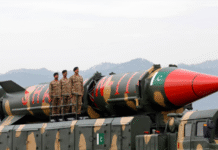Rampal power plant near at the Sunderbans could drastically worsen air pollution and cause approximately 6,000 premature deaths in its lifetime, said coal and air pollution specialist of Greenpeace Lauri Myllyvirta on Friday through a video conference.
He assessed that the coal-based 1,320MW plant would be the single largest source of air pollution in Bangladesh.
Greenpeace is a Netherland-based international non-governmental environmental organisation.
National Committee to Protect Sunderbans, Doctors for Health and Environment and Bangladesh Paribesh Andolan jointly organised the conference at Dhaka Reporters’ Unity auditorium to reveal an international study-conducted by Lauri.
After assessing the probable emissions of the coal-based installation and long range transport of air pollutants, Lauri said that hazardous particles released from the plant would badly impact the air quality of Khulna, Ashoknagar, Kalyangarh, Sathkhira, Begumganj, Bashirhat, Narsingdi, Noakhali, Bashipur and Comilla.
He said the estimated health impacts due to pollutant particles and gaseous substances would be approximately 6,000 premature deaths during a 40-year operational life.
He added the estimated number of babies born with a low birth weight due to the pollution would be 600 per year.
The study was conducted using the CALPUFF air pollution modelling system recommended by the United States’ Environment Protection Agency for assessing long range transport of pollutants and their impacts.
Labelling the estimated emission limits in the tender documents for the plants faulty, Laury assessed that emission of sulphur dioxide, nitrogen oxide, dust and mercury would be five to ten times as high as emission rates associated with the best regulatory practice and best available technologies.
He said that projected mercury deposition from the plant could be sufficient to render fish unsafe to eat over an area of approximately 70 square kilometres around the power plant.
Paediatric Nazmun Nahar, president of Doctors for Health and Environment, warned that the emissions of the plant, especially mercury, would threaten the health of mothers living around the South-west part of the country.
Chair of the conference and convener of the national committee, Sultana Kamal again blamed the government for disseminating false information among the people that the plant would be a less-pollutant super-critical installation.
Bangladesh Paribesh Andolan’s general secretary Md Abdul Matin and Professor Abu Sayeed of DHE also addressed the conference.
The United Nations has already urged Bangladesh to halt construction, warning it poses an unacceptable risk to the UNESCO-protected mangroves that provide a barrier against deadly storm surges and cyclones.
The plant — a joint project by India and Bangladesh — would be powered by nearly five million tonnes of coal shipped every year along the mangroves’ fragile waterways, a natural habitat for endangered Bengal tigers and rare Irrawaddy dolphins.
Scheduled to open in 2018, the plant is projected to discharge nearly 125,000 cubic metres of chemically-tainted water every day into nearby water catchments, Greenpeace said.
The UN warned in October that the plant would ‘irreversibly damage’ the pristine forest, which was declared a UNESCO World Heritage site in 1997.
The dense mangroves provide a buffer against violent weather roaring into the delta, which has killed thousands living in impoverished coastal villages and islands in recent years.
There was no immediate comment from Bangladeshi authorities or the joint-venture company bankrolling the $1.7-billion plant.
Bangladeshi prime minister Sheikh Hasina has defended the project and rejected concerns about its impact as politically motivated.
The project has galvanised street protests in Bangladesh, with campaigners calling for the plant to be scrapped or relocated.
He assessed that the coal-based 1,320MW plant would be the single largest source of air pollution in Bangladesh.
Greenpeace is a Netherland-based international non-governmental environmental organisation.
National Committee to Protect Sunderbans, Doctors for Health and Environment and Bangladesh Paribesh Andolan jointly organised the conference at Dhaka Reporters’ Unity auditorium to reveal an international study-conducted by Lauri.
After assessing the probable emissions of the coal-based installation and long range transport of air pollutants, Lauri said that hazardous particles released from the plant would badly impact the air quality of Khulna, Ashoknagar, Kalyangarh, Sathkhira, Begumganj, Bashirhat, Narsingdi, Noakhali, Bashipur and Comilla.
He said the estimated health impacts due to pollutant particles and gaseous substances would be approximately 6,000 premature deaths during a 40-year operational life.
He added the estimated number of babies born with a low birth weight due to the pollution would be 600 per year.
The study was conducted using the CALPUFF air pollution modelling system recommended by the United States’ Environment Protection Agency for assessing long range transport of pollutants and their impacts.
Labelling the estimated emission limits in the tender documents for the plants faulty, Laury assessed that emission of sulphur dioxide, nitrogen oxide, dust and mercury would be five to ten times as high as emission rates associated with the best regulatory practice and best available technologies.
He said that projected mercury deposition from the plant could be sufficient to render fish unsafe to eat over an area of approximately 70 square kilometres around the power plant.
Paediatric Nazmun Nahar, president of Doctors for Health and Environment, warned that the emissions of the plant, especially mercury, would threaten the health of mothers living around the South-west part of the country.
Chair of the conference and convener of the national committee, Sultana Kamal again blamed the government for disseminating false information among the people that the plant would be a less-pollutant super-critical installation.
Bangladesh Paribesh Andolan’s general secretary Md Abdul Matin and Professor Abu Sayeed of DHE also addressed the conference.
The United Nations has already urged Bangladesh to halt construction, warning it poses an unacceptable risk to the UNESCO-protected mangroves that provide a barrier against deadly storm surges and cyclones.
The plant — a joint project by India and Bangladesh — would be powered by nearly five million tonnes of coal shipped every year along the mangroves’ fragile waterways, a natural habitat for endangered Bengal tigers and rare Irrawaddy dolphins.
Scheduled to open in 2018, the plant is projected to discharge nearly 125,000 cubic metres of chemically-tainted water every day into nearby water catchments, Greenpeace said.
The UN warned in October that the plant would ‘irreversibly damage’ the pristine forest, which was declared a UNESCO World Heritage site in 1997.
The dense mangroves provide a buffer against violent weather roaring into the delta, which has killed thousands living in impoverished coastal villages and islands in recent years.
There was no immediate comment from Bangladeshi authorities or the joint-venture company bankrolling the $1.7-billion plant.
Bangladeshi prime minister Sheikh Hasina has defended the project and rejected concerns about its impact as politically motivated.
The project has galvanised street protests in Bangladesh, with campaigners calling for the plant to be scrapped or relocated.
Source: New Age









